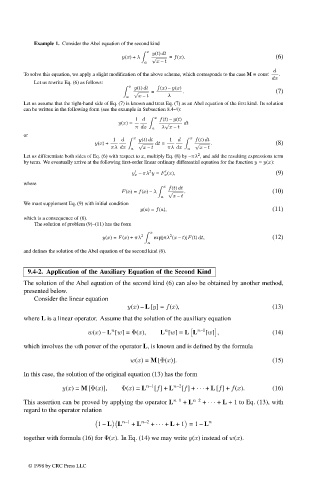Page 488 - Handbook Of Integral Equations
P. 488
Example 1. Consider the Abel equation of the second kind
x y(t) dt
y(x)+ λ √ = f(x). (6)
a x – t
d
To solve this equation, we apply a slight modification of the above scheme, which corresponds to the case M ≡ const .
dx
Let us rewrite Eq. (6) as follows:
x y(t) dt f(x) – y(x)
√ = . (7)
a x – t λ
Let us assume that the right-hand side of Eq. (7) is known and treat Eq. (7) as an Abel equation of the first kind. Its solution
can be written in the following form (see the example in Subsection 8.4-4):
1 d x f(t) – y(t)
y(x)= √ dt
π dx a λ x – t
or
1 d x y(t) dt 1 d x f(t) dt
y(x)+ √ dt = √ . (8)
πλ dx a x – t πλ dx a x – t
2
Let us differentiate both sides of Eq. (6) with respect to x, multiply Eq. (8) by –πλ , and add the resulting expressions term
by term. We eventually arrive at the following first-order linear ordinary differential equation for the function y = y(x):
2
y x – πλ y = F x (x), (9)
where
x f(t) dt
F(x)= f(x) – λ √ . (10)
a x – t
We must supplement Eq. (9) with initial condition
y(a)= f(a), (11)
which is a consequence of (6).
The solution of problem (9)–(11) has the form
x
2
y(x)= F(x)+ πλ 2 exp[πλ (x – t)]F(t) dt, (12)
a
and defines the solution of the Abel equation of the second kind (6).
9.4-2. Application of the Auxiliary Equation of the Second Kind
The solution of the Abel equation of the second kind (6) can also be obtained by another method,
presented below.
Consider the linear equation
y(x) – L [y]= f(x), (13)
where L is a linear operator. Assume that the solution of the auxiliary equation
n
n
w(x) – L [w]= Φ(x), L [w] ≡ L L n–1 [w] , (14)
which involves the nth power of the operator L, is known and is defined by the formula
w(x)= M [Φ(x)]. (15)
In this case, the solution of the original equation (13) has the form
y(x)= M [Φ(x)], Φ(x)= L n–1 [f]+ L n–2 [f]+ ··· + L [f]+ f(x). (16)
This assertion can be proved by applying the operator L n–1 + L n–2 + ··· + L + 1 to Eq. (13), with
regard to the operator relation
n–1 n–2 n
1 – L L + L + ··· + L +1 =1 – L
together with formula (16) for Φ(x). In Eq. (14) we may write y(x) instead of w(x).
© 1998 by CRC Press LLC
© 1998 by CRC Press LLC
Page 470

